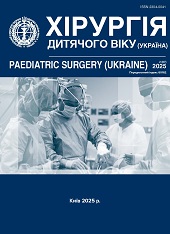Organization of medical care for pregnant women, fetuses and children with critical congenital malformations in a multifunctional perinatal center
DOI:
https://doi.org/10.15574/PS.2025.2(87).1620Keywords:
congenital malformations, diaphragmatic hernia, gastroschisis, congenital small intestinal obstruction, tumors in children, sacrococcygeal teratoma, fetus, newborn child, older child, organization of care, perinatal supportAbstract
Aim - to develop a concept for providing medical care to pregnant women, their fetuses and children with complex congenital malformations in a multifunctional perinatal center, to assess postoperative mortality of patients with critical congenital malformations.
Materials and methods. A retrospective analysis of medical records of 437 children was performed, and the levels of postoperative mortality in patients with complex and critical congenital malformations who underwent surgical correction of the defect in the conditions of the SI «Ukrainian center of maternity and childhood of the NAMS of Ukraine» were studied, in the period from 1981 to 2025.
Results. The proposed concept of organizing medical care for pregnant women, fetuses and newborns made it possible to reduce the mortality of newborns with congenital malformations: in congenital small bowel obstruction from 37.5% to 11.4% (with high obstruction) and from 56.3% to 26.3% (with low). In diaphragmatic hernia, a decrease in postoperative mortality was noted from 56.6% to 9.7%. In gastroschisis, the total postoperative mortality with both uncomplicated and complicated forms decreased from 63.0% to 14.4%, since 2018 - 0%.
Conclusions. The development and implementation of the concept of organizing medical care for pregnant women, fetuses and children with critical congenital malformations in the conditions of a multifunctional perinatal center made it possible to significantly reduce postoperative mortality of patients and achieve mortality values identical to the results of leading world clinics.
No conflict of interests was declared by the author.
References
Ameh EA, Chirdan LB. (2000). Ruptured exomphalos and gastroschisis: a retrospective analysis of morbidity and mortality in Nigerian children. Pediatr. Surg. Int. 16: 23-25. https://doi.org/10.1007/s003830050006; PMid:10663828
Bacino C. (2017). Birth defects: epidemiology, types, and patterns. UpToDate. Accessed July 2, 2018.
Bergholz R, Boettcher M, Reinshagen K, Wenke K. (2014, Oct). Complex gastroschisis is a different entity to simple gastroschisis affecting morbidity and mortality-a systematic review and meta-analysis. J Pediatr Surg. 49(10): 1527-1532. https://doi.org/10.1016/j.jpedsurg.2014.08.001; PMid:25280661
CDC. (2020). Smoking during pregnancy [website].Atlanta: Centres for Disease Control and Prevention. URL: https://www.cdc.gov/tobacco/basic_information/health_effects/pregnancy/index.htm.
CDC Foundation. (2024). What is public health? [website]. Atlanta: Centres for Disease Control and Prevention. URL: https://www.cdcfoundation.org/what-public-health. Accessed 2 May 2023.
Chen Q-J, Gao Z-G, Tou J-F, Qian Y-Z, Li M-J et al. (2014). Congenital duodenal obstruction in neonates: a decade's experience from one center. World J Pediatr. 10(3): 238-44. Epub 2014 Aug 15. https://doi.org/10.1007/s12519-014-0499-4; PMid:25124975
Chimah OU, Emeagui KN, Ajaegbu OC, Anazor CV, Ossai CA et al. (2022, Apr 13). Congenital malformations: Prevalence and characteristics of newborns admitted into Federal Medical Center, Asaba. Health Sci Rep. 5(3): e599. https://doi.org/10.1002/hsr2.599; PMid:35509389 PMCid:PMC9059225
Escobar MA, Ladd AP, Grosfeld JL, West KW, Rescorla FJ, Scherer LR 3rd et al. (2004). Duodenal atresia and stenosis: long-term follow-up over 30 years. Pediatr Surg. 39(6): 867-71. https://doi.org/10.1016/j.jpedsurg.2004.02.025; PMid:15185215
Livingston MH, DCruz J, Pemberton J, Ozgediz D, Poenaru D. (2015). Mortality of pediatric surgical conditions in low and middle income countries in Africa. J Pediatr Surg. 50(5):760-764. Epub 2015 Feb 20. https://doi.org/10.1016/j.jpedsurg.2015.02.031; PMid:25783373
Lopez A, Benjamin RH, Raut JR, et al. (2019). Mode of delivery and mortality among neonates with gastroschisis: A population-based cohort in Texas. Paediatr Perinat Epidemiol. 33(3): 204-212. https://doi.org/10.1111/ppe.12554; PMid:31087678 PMCid:PMC7028334
Nagata K, Usui N, Kanamori Y, Takahashi S, Hayakawa M, Okuyama H et al. (2013). The current profile and outcome of congenital diaphragmatic hernia: a nationwide survey in Japan. J Pediatr Surg. 48: 738-744. https://doi.org/10.1016/j.jpedsurg.2012.12.017; PMid:23583127
Vinit N, Benachi A, Rosenblatt J, Jouannic JM, Rousseau V, Bonnard A et al. (2024, Nov). Growth velocity of fetal sacrococcygeal teratoma as predictor of perinatal morbidity and mortality: multicenter study. Ultrasound Obstet Gynecol. 64(5): 651-660. https://doi.org/10.1002/uog.29110; PMid:39482803
Wessel LM, Fuchs J, Rolle U. (2015). The Treatment of Diaphragmatic Hernia, Esophageal Atresia and Small Bowel Atresia. Dtsch Arztebl. 112(20):357-64. https://doi.org/10.3238/arztebl.2015.0357; PMid:26051693 PMCid:PMC4558645
World Health organization. (2015). International statistical classification of diseases and related health problems, 10th revision. Geneva. URL: https://icd.who.int/browse10/2019/en. Accessed 5 May 2023.
World Health Organization. (2023). Congenital Anomalies. World Health Organization. Accessed February 27, 2023.
World Health Organization. (2015). Congenital Anomalies. World Health Organization. Accessed July 2, 2018.
World Health Organization. (2023). Congenital disorders. Geneva. URL: https://www.who.int/news-room/fact-sheets/detail/birth-defects. Accessed 2 May 2023.
Zolfizadeh F, Ghorbani M, Soltani M, Rezaeian S, Rajabi A, Etemad K et al. (2022, May). Factors Associated with Infant Mortality Due to Congenital Anomalies: A Population-Based Case-Control Study. Iran J Public Health. 51(5): 1118-1124. https://doi.org/10.18502/ijph.v51i5.9411; PMid:36407744 PMCid:PMC9643240
Downloads
Published
Issue
Section
License
Copyright (c) 2025 Paediatric Surgery (Ukraine)

This work is licensed under a Creative Commons Attribution-NonCommercial 4.0 International License.
The policy of the Journal “PAEDIATRIC SURGERY. UKRAINE” is compatible with the vast majority of funders' of open access and self-archiving policies. The journal provides immediate open access route being convinced that everyone – not only scientists - can benefit from research results, and publishes articles exclusively under open access distribution, with a Creative Commons Attribution-Noncommercial 4.0 international license(СС BY-NC).
Authors transfer the copyright to the Journal “PAEDIATRIC SURGERY.UKRAINE” when the manuscript is accepted for publication. Authors declare that this manuscript has not been published nor is under simultaneous consideration for publication elsewhere. After publication, the articles become freely available on-line to the public.
Readers have the right to use, distribute, and reproduce articles in any medium, provided the articles and the journal are properly cited.
The use of published materials for commercial purposes is strongly prohibited.

